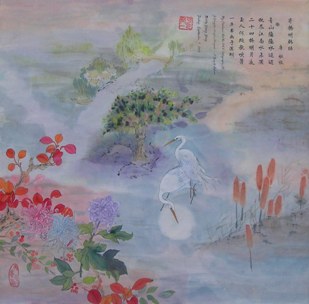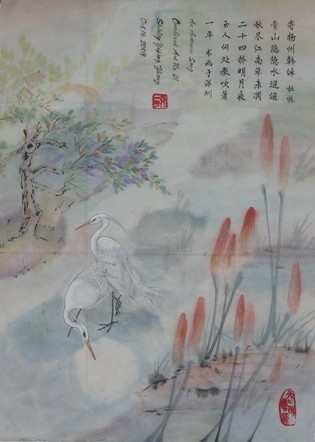 Listen to Shirley Singing the Poem in English & Chinese Oct, 2009
Listen to Shirley Singing the Poem in English & Chinese Oct, 2009 Listen to Shirley Singing the Poem in Chinese Sep, 2007
Listen to Shirley Singing the Poem in Chinese Sep, 2007 Listen to Shirley Explaining the Poem Oct 18, 2009
Listen to Shirley Explaining the Poem Oct 18, 2009 Follow Shirley to Read the Poem & the New Words Oct,18, 2009
Follow Shirley to Read the Poem & the New Words Oct,18, 2009 Learn the Meaning of this Poem With Shirley Together
Learn the Meaning of this Poem With Shirley Together See Shirley Created Picture for the Poem Oct 17, 2009
See Shirley Created Picture for the Poem Oct 17, 2009 See Shirley Created Picture for the Poem Sep 9, 2007
See Shirley Created Picture for the Poem Sep 9, 2007This is my 21st
Combined Paintingthat I created for Chinese Classical Poetry. It is
my 451th painting since 2003 I created 42 Chinese Xieyi paintings and 1 Chinese Gongbi Painting during I was in the US, but, I did not create any integrated art works even though I had bought some music instrument for the job. Anyway, I have not been stopping thinking of this "Project" and I made it as the summary of my painting, music and language learning. I wanted to build my own art style from this kind of creation.
So, as soon as I re-started my Chinese art lesson on Tuesday night, I corrected a Chinese Baimiao Wednsday early morning and Re-created this painting on Friday night.
I created the painting below to match
a Chinese classical poem and to help you to understand the meaning of this poem September 9, 2007. My teacher gave me 95 scores to encourage my work at that time. But, 4 days ago ? Oct 13, 2009, when we discussed that whether we should send this painting to a professional company to fix it with the other better works together, both of us said “No”, because we thought it was a little bit mess, the theme is not outstanding.
So, I re-created it Friday night and tried to make its theme clearer.
I re-wrote the Calligraphy, corrected the poem’ comments and music, re-played and re-sang the poem on the weekend.
I do hope to help you to understand the meaning of the poem, the painting and the Chinese culture behind the painting and the poem…
You are welcome to hit the links, to read, to listen to and to learn this Chinese poem…
For making a convenience for you you to Here are the original poem and the meaning in English:
MAIN MEANING OF THE POEM: Green mountains are indistinct,
(The mountain is green ? When I was singing, I correct it)Blue rivers are flowing far away,
(The is blue -- When I was singing, I correct it)Fall ends in Jiangnan
Grass is not yellow.
Twenty-four bridge and Bright moonlight,
where are you teaching people blowing flute?
Blowing flute?
CHINESE CHARACTER AND PRONUNCIATION 寄扬州韩绰判官--Ji Yangzhou Haichuo Paiguang
杜牧 -- Du Mu
青山隐隐水迢迢--qīngshān yǐnyǐn shuǐ tiáotiáo,
秋尽江南草未凋--qīujìn jiāngnán cǎo wèi diāo。
二十四桥明月夜--ěrshísì qiáo míngyuè yè,
玉人何处教吹箫--yùrén héchù jiào chuīxiāo。
How do you think of this painting? Compared with the original one, which one seems like better?

If you have any questions, comments and suggestions, please write to
shirley@ebridge.cn or
shirleyz004@yahoo.com. You are welcome to publish your opinions in
Forum as well.
Shirley ZhangWrittern unday, Oct 18, 2009

 Listen to Shirley Singing the Poem in English & Chinese Oct, 2009
Listen to Shirley Singing the Poem in English & Chinese Oct, 2009 Listen to Shirley Singing the Poem in Chinese Sep, 2007
Listen to Shirley Singing the Poem in Chinese Sep, 2007 Listen to Shirley Explaining the Poem Oct 18, 2009
Listen to Shirley Explaining the Poem Oct 18, 2009 Follow Shirley to Read the Poem & the New Words Oct,18, 2009
Follow Shirley to Read the Poem & the New Words Oct,18, 2009 Learn the Meaning of this Poem With Shirley Together
Learn the Meaning of this Poem With Shirley Together See Shirley Created Picture for the Poem Oct 17, 2009
See Shirley Created Picture for the Poem Oct 17, 2009 See Shirley Created Picture for the Poem Sep 9, 2007
See Shirley Created Picture for the Poem Sep 9, 2007